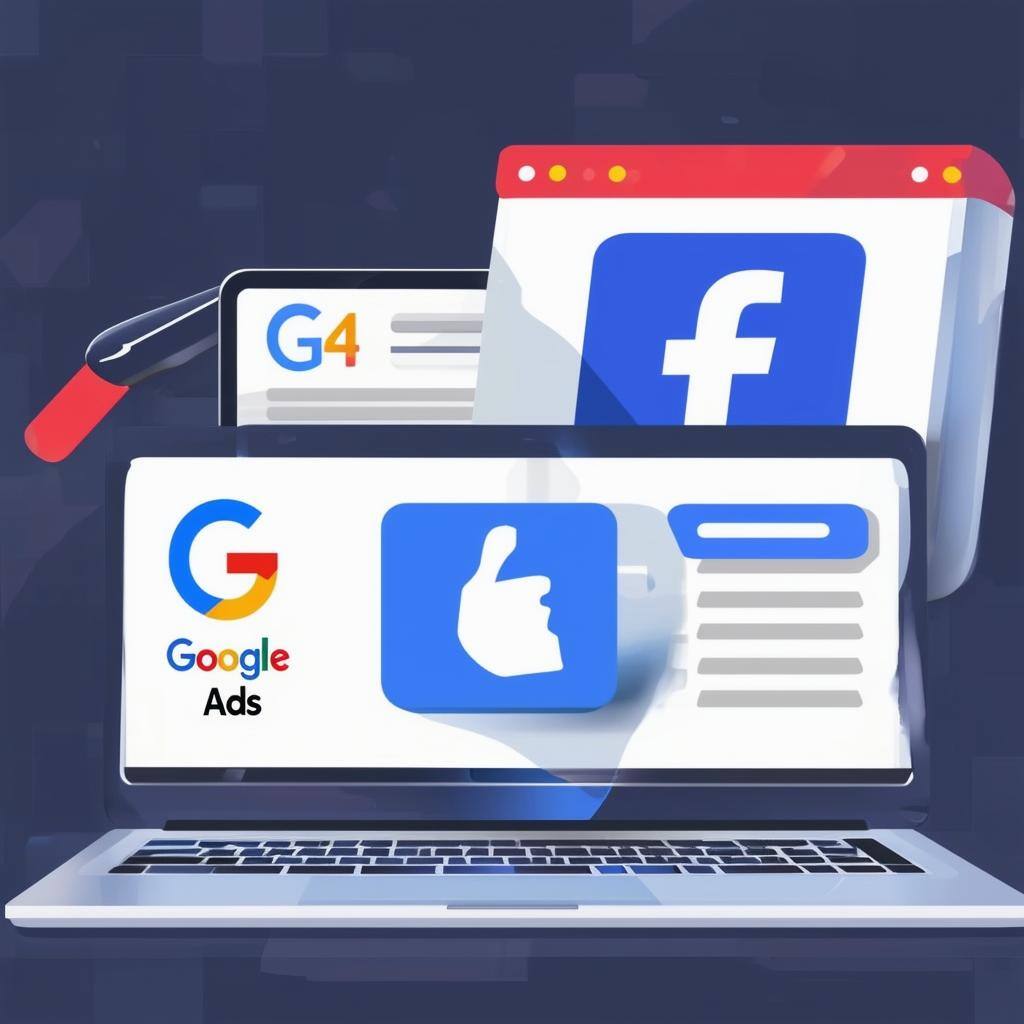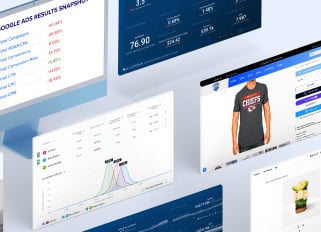
The Pros and Cons of Google Ads vs. Facebook Ads for E-Commerce
Digital advertising is the lifeblood of many thriving e-commerce businesses today. With countless paid advertising platforms available, Google Ads and Facebook Ads reign supreme as the go-to choices for entrepreneurs looking to grow their online stores. Both platforms can deliver exceptional results, but their strengths and weaknesses depend heavily on your business goals, audience, and budget.
So, Google Ads vs Facebook Ads: which one is better for e-commerce?
This guide will break down the advantages and disadvantages of both ad platforms, helping you make an informed decision for your business.
Understanding the Basics
Before comparing the pros and cons, it's essential to understand how both Google Ads and Facebook Ads function and what makes each unique. In these next sections, we’ll go into exactly what makes each of these ads different and why both are widely used by businesses around the globe.
What Are Google Ads?
Google Ads (formerly Google AdWords) is a pay-per-click (PPC) platform that enables businesses to target users based on their search intent. When users search for specific keywords on Google, relevant ads appear at the top of search results, giving businesses access to high-intent potential customers. Additionally, Google Ads offers Display Ads, Shopping Ads, and YouTube Ads for different engagement strategies.
Key Targeting Options:
- Keyword targeting: Your ads appear based on specific search terms.
- Location-based targeting: Reach users in particular geographic locations.
- Device-based targeting: Display ads based on device types (desktop, mobile, etc.).
How Do Google Ads Work?
Google Ads offers various ad formats, with Google search ads being the most common. These text-based ads appear on the Search Engine Results Page (SERP) based on their relevance to specific keywords and the amount advertisers bid for those terms. Other options include Google Display Ads, which are image-based banner ads shown across the Google Display Network, and Google Shopping Ads, which showcase specific products directly in search results.
Additionally, Google Ads allows advertisers to target their audience effectively by focusing on search intent using keywords and phrases, as well as demographic factors like age, gender, location, family status, and income.

What Are Facebook Ads?
Facebook Ads is a paid social media advertising platform that allows businesses to promote products and services to its 2.9 billion monthly active users. Unlike Google Ads, which taps into search intent, Facebook Ads focuses on interest-based targeting to connect with potential customers emotionally and contextually.
Key Targeting Options:
- Demographic targeting: Focus on age, gender, education, etc.
- Interest targeting: Reach people based on hobbies, likes, or past behaviors.
- Custom audiences: Retarget users who’ve interacted with your website or ads.
How Do Facebook Ads Work?
The Facebook Ads Manager interface makes it easy for businesses to create and manage campaigns. Advertisers start by selecting their campaign objective, target audience, ad budget, ad format, and other key elements before launching their ads. These ads appear in users’ feeds across Meta apps like Facebook and Instagram, blending in with regular posts except for the “Sponsored” label shown under the profile name.
Facebook’s advanced targeting options allow advertisers to reach the right audience based on demographics such as age, gender, location, family status, and household income, as well as user interests and behaviors, like interactions with friends, pages, or previously clicked ads.
Thanks to Facebook’s algorithm, ads are shown to users who are most likely to engage with them. This means the more data you have on your target audience, the more effective your campaign can be.
Moreover, the platform supports both pay-per-click (PPC) and pay-per-impression (PPM) campaigns, charging advertisers per 1,000 impressions.
Google Ads vs. Facebook Ads: Key Similarities and Differences
Given their different purposes, Google Ads and Facebook Ads differ in several ways.
Targeting Options
Both platforms offer powerful targeting options to help advertisers connect with the right audience. However, while Google Ads focuses on search intent and demographics, Facebook Ads taps into user interests and behaviors. This means that businesses looking to reach customers based on their specific needs should opt for Google Ads, while those aiming for emotional or contextual connections may find success with Facebook Ads.
Ad Formats
Google Ads offers a variety of ad formats, including text-based ads, image display ads, shopping ads, video ads, and more. Facebook, on the other hand, primarily relies on images or videos placed in users' feeds. However, the platform also supports other formats, such as carousel ads, slideshow ads, and collection ads.
Cost
The cost of advertising on both platforms varies depending on several factors, such as your target audience, ad format, competition, and bidding strategy. However, Facebook Ads typically have a lower cost-per-click (CPC) compared to Google Ads due to their higher reach and engagement rates.
Reach and Intent
Google Ads targets users actively searching for specific products or services, leveraging the platform's massive reach as the most visited website in the world, with over 8.5 billion searches per day. This high-intent audience makes Google ads campaigns ideal for driving conversions. Meanwhile, Facebook Ads taps into its three billion monthly active users by targeting interests and behaviors, making it perfect for building brand awareness.
Tracking and Analytics
With Google Ads, advertisers can track conversion rates directly from search results through tools like Google Analytics. Facebook Ads also provides detailed analytics but tends to focus more on engagement metrics like likes, shares, comments, etc.
.jpg?width=700&height=467&name=solen-feyissa-UWVJaDvXW_c-unsplash%20(2).jpg) Advantages of Leveraging Google Ads for E-Commerce
Advantages of Leveraging Google Ads for E-Commerce
High Intent Targeting
Google Ads is unparalleled in targeting users who are actively seeking products. If someone searches for "buy wireless headphones," you’re reaching a prospective customer who's ready to make a purchase.
Keyword-Based Advertising
With keyword-based ad strategies, businesses can craft campaigns tailored to relevant keywords or exact phrases their audience is searching for. This ensures relevance and higher chances of conversions.
Versatile Ad Formats
From Google Shopping Ads showcasing product images and prices to YouTube Ads offering immersive video experiences, Google covers nearly every medium to engage users.
Massive Reach
With more than 8.5 billion daily searches conducted on Google, your ads are likely to be seen by your target audience.
Measurable ROI
Google Ads comes with advanced performance tracking tools, making it easy to measure conversions, ad click performance, and return on ad spend (ROAS).
Drawbacks of Using Google Ads for E-Commerce
High Competition
Popular keywords can trigger intense competition, driving up costs per click (CPC). For instance, keywords like "best laptops" can have a CPC of $5 or more.
Learning Curve
To maximize ROI, Google Ads requires a good understanding of keyword research, bid management, and analytics, which can be challenging for beginners.
Costly for Small Budgets
Since Google Ads favors businesses that can allocate higher daily budgets, small e-commerce stores may struggle to sustain high-performing campaigns.
Advantages of Using Facebook Ads for E-Commerce
Precise Audience Targeting
Facebook targets users based on lifestyle, interests, and demographic details, making it the perfect choice for businesses that know their audience well.
Visual Creativity
Facebook Ads enables highly visual formats for social media ads like video ads, carousel ads, and instant experiences to captivate audiences. Perfect for e-commerce brands showcasing their products in action.
Brand Discovery
Facebook Ads can reach users who were previously unaware of your brand, expanding your customer base by introducing products to untapped markets.
Affordable for Small Businesses
With flexible ad placement and costing options, small businesses can start campaigns with as little as $5 per day, allowing e-commerce owners to test and refine ads.
Integrated with Instagram
Facebook Ads also provide access to Instagram’s huge audience, increasing the reach and engagement opportunities for content-rich campaigns.
The Drawbacks of Using Facebook Ads for E-Commerce
Ad Fatigue
Ads on Facebook can quickly become repetitive for users, particularly if they are not refreshed frequently, leading to reduced engagement over time.
Lower Purchase Intent
Many Facebook users aren’t actively looking to buy products—they’re browsing or interacting with content. As a result, conversion rates can be lower than those of Google Ads, which focus on intent-based keyword searches.
Privacy Updates
Apple's data privacy updates have impacted the precision of Facebook Ad targeting on iOS devices, reducing the effectiveness of campaigns for some advertisers.
Requires Creative Efforts
Unlike Google’s text-heavy ads, Facebook campaigns demand high-quality visuals and compelling stories, requiring time and resources to craft.
Making the Decision
When to use Google Ads vs. Facebook Ads is a common dilemma for e-commerce businesses. While both platforms offer unique advantages, the best approach is to use a combination of both for a well-rounded advertising strategy.
Here are some factors to consider:
- Budget: Facebook Ads are typically more affordable, making them great for smaller budgets. Google Ads require larger investments for high-impact campaigns.
- Objective: Use Google Ads for search-driven results (e.g., users ready to buy), and Facebook Ads for discovery-driven objectives (e.g., building brand awareness).
- Audience: If your audience actively uses social media platforms, Facebook Ads' interest-targeting options might be ideal. Conversely, Google Ads are suited for users actively searching for products.
- Type of Product: Highly visual or impulse-buy products tend to perform better on Facebook Ads. Meanwhile, Google is suitable for products with high purchase intent and specific keywords.
FAQs
1. How does Google advertising differ from other platforms?
Google advertising focuses on targeting users who are actively searching for specific products or services. Through ad campaigns that appear in Google search results, businesses can reach high-intent customers when they are looking for solutions, offering a distinct advantage over platforms focused on discovery-driven advertising.
2. Can I use Google advertising for any type of product?
Yes, but it is most effective for products and services that align with specific keywords and cater to users with clear purchase intent. By tailoring your ad campaign to target relevant search queries in Google search results, you can optimize visibility and drive conversions for products or services that buyers are actively seeking.
3. What makes a successful ad campaign on Google?
A successful Google ad campaign relies on precise keyword targeting, compelling ad copy, and strategic bidding. Your ad message must align with the keywords your customers are using in Google search results, and your landing pages must be optimized to meet their expectations.
4. How do I decide where to advertise my products?
Consider your audience and the type of product you are advertising. If your audience actively uses social media and responds well to interest-based targeting, Facebook Ads may be the right choice. For products with high purchase intent, Google Ads are ideal due to their keyword targeting of users actively searching for similar products.
5. What is the difference between paid search and PPC ads?
Paid search refers specifically to advertising on search engines like Google, using a pay-per-click (PPC) model. PPC ads are a broader term that includes any type of advertisement where you pay for clicks, including paid search ads on search engines and display ads on websites.
Take Your Ad Strategy to the Next Level
E-commerce success often hinges on wisely choosing where to allocate your ad spend. By understanding the strengths and limitations of both Google Ads and Facebook Ads, you can align your strategy with your goals, audience, and budget.
Ultimately, combining both platforms can help maximize reach and conversions while catering to different stages of the customer journey. With careful planning and monitoring, e-commerce businesses can leverage the unique strengths of each platform to drive success in their advertising strategies.
But let’s face it: not every team has the time or resources to master Google Ads and Facebook Ads while managing everything else. That’s where BlueTuskr comes in. We specialize in e-commerce paid advertising, leveraging expert PPC and SEO strategies to help businesses thrive across every channel.
Ready to boost your ROI and take your campaigns to the next level? Let BlueTuskr handle the heavy lifting—contact us today to get started!
Connect With Us
Recent Post

.png)





Tell us what you think!